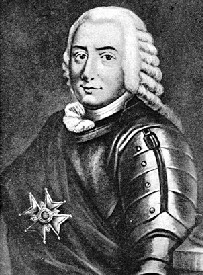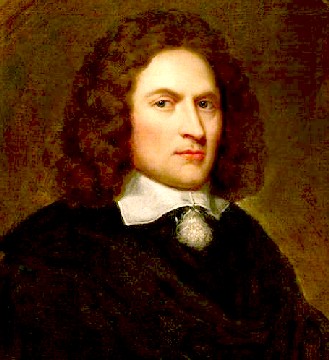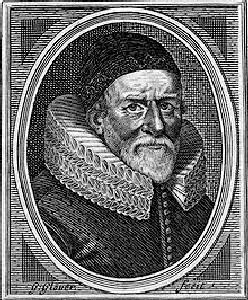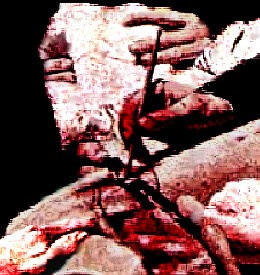
Needle and Suture Pages: 1 2 3 4 5 Next>>
Needles and Suturing in the Golden Age of Piracy, Page 4
Suturing Procedures
"…all good authors command to stitch wounds of necessity, otherwise it would cause a great deformity." (William Clowes, Selected Writings of William Clowes, p. 111)
"The sole advantage which we draw from Sutures is Re-union, in the Procuration of which two things concur, the Chirurgeon and Nature. On the Chirurgeon’s part the observation of two circumstance is absolutely necessary: First, to draw the Lips of the Wound in mutual closure, and secondly to keep them in that situation; and on the side of Natures she is obliged to make use of her Balm, as the most proper Cement to conglutinate and mutually re-unite the Lips of the Wound." (Pierre Dionis, A course of chirurgical operations: demonstrated in the royal garden at Paris. 2nd ed., p. 38)

Surgical Author Pierre Dionis
As discussed previously, suturing was not used as widely during the golden age of piracy as it is today. Many surgeons instead chose to keep wounds open to allow the escape of the "bad" humors that were thought to gather or be generated at a wound site. Others preferred to use dressings instead of sutures to keep the wound closed. Dionis himself admitted "we often affirm Suture to be the best means that can be used for the re-uniting of Wounds just made, when Bandage, favour'd by the most advantageous situation, cannot compass that end"1.
However, Dionis recognized the importance of the surgeon's role in healing a wound using sutures. He specifically puts the surgeon's role ahead of nature in the previous quote because nature "would labour in vain on a Wound, if his [the surgeon's] Industry did not reduce [bring together] the parts to such a state as is reparable by the Motion and Juices provided by her wise Oeconomy to that end."2 Dionis' belief was that without suturing, the flow of the Humors [viscous bodily fluids thought to control health] would not be unable to repair the skin and would just flow into the wound where they would cause problems. Effective suturing allowed wound lips to stay connected so "that the Extremities of the Fibres and Capillary Vessels, mollified and nourished in a small time, [would] proceed to a perfect Continuity [rejoining the skin] of the same Texture as before their Disunion."3
Esteemed military surgeon Richard Wiseman also supported suturing. He strongly rejected the idea of keeping a wound open, drawing upon the writings of the ancient surgeons such as Hippocrates, Galen and Celsus to suggest all wounds should be sutured, except those accompanied by compound fractures.4

Military Surgeon Richard Wiseman
Wiseman explained that the lips of a wound must be brought 'exactly together'. This procedure was
to be observed as a Law; for without that Reduction [bringing together] in the Lips, a flow and deformed Healing follows. Nature hath nothing to do here in bringing the Lips together, that is the sole work of the Chirurgeon; who must not lay a Pledgit, or croud a Dossil of Lint or Tent into a little Wound; no, that is the way to keep the Wound open, and make it painful, whereby Defluxions [flows of humors into the wound] are stirred up, the Temperament of the Part weakened, and the Cure prolonged; contrary to the intention of all who have writ of Wounds, and to the practice of our knowing Chirurgeons here.5
With regard to bleeding wounds, Ambroise Paré suggests the surgeon "observe whether there be any great fluxe or blood present, for he shall stoppe it if it be too violent; but provoke it, if too slow, (unlesse by chance it shall be powred out into any capacity or belly) that so the part freed from the superfluous quantity of blood may be lesse subject to inflammation."6 This explanation has humoral underpinnings as well; blood was one of the humors and most surgeons believed that letting the blood flow out of a wound would force out tainted humors that had gathered there and allow the wound to heal.
1 Pierre Dionis, A course of chirurgical operations: demonstrated in the royal garden at Paris. 2nd ed., p. 37; 2 Dionis, p. 38; 3 Dionis, p. 38-9; 4 Sir James Watt, "Some forgotten contributions of naval surgeons", Journal of the Royal Society of Medicine, Vol. 78, September 1985, p. 754; 5 Richard Wiseman,Of Wounds, Severall Chirurgicall Treatises, p. 341-2; 6 Ambroise Paré, The Apologie and Treatise of Ambroise Paré, p. 123-4;
Suturing Procedures: Principles
Several of the period surgeons provide principles for their readers to keep in mind while suturing wounds. Dionis gives seven 'precepts' of suturing which his students were to observe. Richard Wiseman provides the reader with "five manner of ways; the omitting of any of which will render him negligent of ignorant in his Trade."1 Sea surgeon John Woodall lists a variety of suturing tips.

Sea Surgeon John Woodall
Woodall suggests the surgeon not gather too much skin when suturing so that the "flesh bee not overthicke which you take up with your needle"2. Dionis also mentions the amount of skin sutured, advising his students "not to take in too much of the Skin, by piercing it obliquely"3.
Ambroise Paré agrees, telling his readers neither to "take hold of too much nor too little flesh with your needle, for too little will not hold, and too much causeth paine and inflammation. And besides leave an ill favoured scarre."4 He also suggests a caveat to this advice, noting that "in deepe wounds, such as are those which are made in the thicker Muscles, the needle must be thrust home, that so it may comprehend more of the fleshy substance; least the thred drawne away by the weight of the flesh not taken hold of may bee broken."5
Woodall advises the surgeon to "let not your stitches be too close [together]"6, which is echoed by Dionis who says "to leave a moderate distance between the Stitches"7. Woodall explains why close stitches are a problem, telling his surgeon's mates not to "tie your silke too close, which will occasion the stitches to breake before their time, for Nature will not be forced."8
Woodall also warns his charges "when you stitch beware you draw not the orifice awry, oblique or deformed, but that you have great respect to the true beauty and former comelinesse of the wounded part."9 Military surgeon Richard Wiseman likewise advises bringing the wound lips together in a manner "that they may by Consolidation be restored to their former figure"10. To help assure proper suturing, Dionis suggested that the wound's "Lips be join’d by a Servant, who holds them close during the Operation"11, thus freeing the surgeon to concentrate on suture technique instead of the proper positioning of the lips of the wound.

Artist: Thomas Eakins
Suturing a Wound, The Gross Clinic (1875)
Among his other precepts, Pierre Dionis orders the surgeon to cleanse the wound "of all clots of Blood, and other exotic Bodies"12 before suturing. Paré advises the surgeon to make sure that "no heterogeneous or strange body remaines" after cleaning a wound13.
Richard Wiseman goes into greater detail on this point, ordering his readers to be "careful and diligent taking away all such extraneous bodies as by their interposition may hinder the true Agglutination of the disjoynted Parts, whether they be concrete Bloud, Hair, Sand, Dust, pieces of Bones, Cartilages, or pieces of the Weapons, Rags &c."14 It is notable that this consideration had as much to do with the wound being able to rejoin properly as anything. Infection was not well understood at this point.
Dionis advised doctors to avoid puncturing "Nerves, Membranes and Tendons", as this would cause the patient unnecessary pain.15 In a similar vein, Wiseman recommends "preventing ill Accidents, and correcting such as have already seized on the Part."16
Dionis also warned surgeons "not to penetrate the Flesh deeper than is necessary, to avoid leaving at the bottom of the Wound, a space where the Humours may amass and putrify"17. This is an interesting comment because it suggests a theory on how bad humors were generated at a wound site. In Dionis' explanation, the humors were not intrinsically bad, but putrefied or decomposed from sitting unused where they didn't belong.
1 Richard Wiseman,Of Wounds, Severall Chirurgicall Treatises, p. 340; 2 John Woodall, the surgions mate, p. 137; 3 Pierre Dionis, A course of chirurgical operations: demonstrated in the royal garden at Paris. 2nd ed., p. 41; 4 Ambroise Paré, The Apologie and Treatise of Ambroise Paré, p. 128; 5 Paré, p. 127-8; 6 Woodall, p. 26; 7 Dionis, p. 41; 8,9 Woodall, p. 26; 10 Wiseman, p. 340; 11,12 Dionis, p. 41; 13 Paré, p. 127; 14 Wiseman, p. 340; 15, Dionis, p. 41; 15 Wiseman, p. 340; 17, Dionis, p. 41
Suturing Procedures: Stitches
Golden age of piracy era surgeons discuss a variety of different suture stitch types. Many of them use different names to refer to the same stitch, which is further complicated by the fact that these stitches have names today that are different than any of those used during the period.

Artist: David Teniers II
Barber Surgeon Detail (17th century)
French surgical instructor Pierre Dionis divides basic sutures into the three types which he says were invented by 'the ancients'. These include: 1) Incarnative sutures - designed to bring the wound edges together so they can incarn (develop flesh and reunite), 2) Restringent sutures - which are intended to stop bleeding, and 3) Conservative sutures - which are used to close large and deep wounds.1
Dionis rejects the second and third types of suturing. With regard to Restringent sutures, he points out that the skin can't be sewn so "that the Blood could not come out... [it would] escape under it [the suture] thro’ the Aperture of the Vessel, from whence [it] would run into all the distant spaces"2 Regarding the Conservative suture, Dionis says that "‘tis needless to run a parcel of long Threads a-cross a Wound, where they fatigue us [surgeons] in the Dressing; and by their attraction, incessantly irritate the Motion and natural Bent of the parts, ‘till they are cut or break; wherefore I dismiss it", recommending a bandage be used to close large wounds instead.3
Dionis focuses instead on his 'Incarnative sutures', identifying two sub-types that he believes to be effective in "re-uniting the Edges of a wound, and retaining them so

Artist: Jonas Arnold Delineavi
Incarnative Suture With Several Needles, From
Armamentarium
Chirurgicum Bipartitum,
by Johannes Scultetus, p. 127 (1666)
join'd... [causing the wound edges] to conglutinate, knit, heal over, and re-assume their pristine Continuity."4 These two subtypes of incarnative sutures he calls the Interstitched/Intersected suture and the Tortile/Threaded suture.
Here the naming of the sutures becomes an issue. Some of the other period authors simply refer to Dionis' Interstitched/Intersected suture as the Incarnative stitch.5 (This is the same name Dionis' uses to class all sutures designed to join the edges of a wound.) Ambroise Paré refers to it as the Interpunctus suture6, although that term is not used anywhere else. The modern term for this suture is the Simple Interrupted Stitch. Although Dionis' over-classification makes sense, we will refer to it here as the Incarnative stitch in keeping with name used by the majority of surgeons.
Dionis' Tortile/Threaded stitch is given a variety of names by other period authors including the intertwisted7 and the conserver8 suture. It has no modern name because it is no longer used. Since there is no period agreement on the name of this stitch, we will refer to it as the Threaded suture.
The third type of suture used during this time is one of those rejected by Dionis: the Conservative suture - the one he indicates is used stop bleeding. Military surgeon Richard Wiseman calls this the Glover's stitch. The modern name is the Continuous Lock Stitch suture. Although Dionis rejects the blood-stopping power of this suture, he admits that it is advisable in a certain cases.
1 Pierre Dionis, A course of chirurgical operations: demonstrated in the royal garden at Paris. 2nd ed., p. 38; 2 Dionis, p. 38-9; 3 Dionis, p. 39; 4 Dionis, p. 38; 5 See for example: Richard Wiseman,Of Wounds, Severall Chirurgicall Treatises, p. 345 & Nathan Bailey, "Suture", The universal etymological English dictionary, Volume 2, 1731, not paginated; 6 Ambroise Paré, The Apologie and Treatise of Ambroise Paré, p. 127; 7 Bailey, "Suture", not paginated; 8 Wiseman, p. 344;
Suturing Procedures: Stitches - Incarnative Stitch
The most widely discussed stitch from the golden age of piracy is the incarnative stitch. Richard Wiseman notes, that this stitch "is in most use amongst us"1. In fact, it is mentioned by all of the period surgeons under study who explain skin suturing in any detail.
To prepare for this stitch, Ambroise Paré explains that the surgeon should use a smooth, three point square needle "so it may the better enter the skin" with the 'head of it some what hollowed' (most likely referring to the gutter discussed in the section on needles) so "that the threed may lie therein; for so the needle will the better goe through."2 He also directs the surgeon to have a cannula for Incarnative stitching "which you
_Olek_Remesz.jpg)
Artist: Olek Remesz
Incarnative Suture (Simple Interrupted)
must hold and thrust against the lip of the wound, that it bee not moved to the one side or other, whilest you thrust thorough the needle... [allowing the surgeon to] hold the lip of the wound in more firmly, that it follow not at the drawing forth of the needle and threed."3
Pierre Dionis explains that incarnative sutures can be made with either single or double thread. When using single thread, the surgeon
takes his Threaded Needle in his Right [hand], and the Tube [cannula] in his Left Hand. Some will have the point dip’d in Oil, that it may give the less Pain at its entrance; then supporting the superior Lip of the Wound with the Tube, the Operator thrusts in the Needle, and when ‘tis passed half thro’ the Hole or Window of the said Tube, he draws it quite through; after which, doing the same thing to the inferior Lip, he passes the same thread through that from within, outwards4.
In Incarnative sutures, the surgeon is to knot and cut the suture thread after each individual stitch, "taking care not to tye the knot on the Wound, but at the upper part of it; he must tye a Chirurgeon’s knot, which is done by passing the Thread twice through the same noose, by reason it holds better than the single knot. Some Chiurgeons place very small Linen Bolsters [small pieces of rolled cloth], D D, under each knot."5
Paré suggests that the knot be "neere to which cut off the threed; least that if any of it bee left below the knot it may so stick to the Emplasters [bandages with plaster on them] that it cannot be plucked and separated from them without paine, when they are taken off."6

Instructions on Performing incarnative Stitching
From Surgery,
By Charles William Mansell Moullin, p. 170
When the suture is performed with double thread, Dionis directs the surgeon to make a loop at the end of the thread "and when he has run it through the Wound... the loop left at the inferior part [2nd side of the skin pierced] of the Wound is raised to the superior [1st side of the skin pierced], and the thread run through it, after which having tied it with a double knot, he cuts it". So in this case, the thread is drawn back over the skin and fed into the loop on the opposite side and tied. Dionis explains that this has the advantage of being stronger and closing more 'exactly.'7
Both Paré and Wiseman order Incarnative suturing to begin in the middle of the wound, where the gap is usually the widest, and proceed outwards from the middle towards each end.8 Wiseman recommends making the stitches about a finger's breadth apart, noting that if a wound is only "the length of a finger’s breadth or a little more, ‘tis not worth the stitching: our Medicaments and Bandage will keep the Lips together, and quickly heal it."9
Pare warns that "the lips of the wound must not be too closely joyned, but a little space must be left open betweene them, that the matter may have free passage forth"10. He explains that this will avoid inflammation, pain, the formation of pus and matter coming from the wound such that "the lips will be so much distended that they may easily be broken by the stifnesse of the threed."11 Sea surgeon John Moyle agrees advising his readers not to make the "stitches be too close, but that there may be room for the blood or matter to come forth"12.
1 Richard Wiseman,Of Wounds, Severall Chirurgicall Treatises, p. 344; 2,3 Ambroise Paré, The Apologie and Treatise of Ambroise Paré, p. 127; 4 Pierre Dionis, A course of chirurgical operations: demonstrated in the royal garden at Paris. 2nd ed., p. 41-2; 6,7 Dionis, p. 42; 8 See Paré, p. 127 and Wiseman, p. 345; 9 Wiseman, p. 345; 10 Paré, p. 127-8; 11 Paré, p. 128; 12 John Moyle, Abstractum Chirurgæ Marinæ, p. 53
Suturing Procedures: Stitches - Threaded Stitch

Threaded Suture, Shown on Harelip, From The Workes of
that Famous
Chirurgion Ambrose Pare, p. 294 (1649)
The threaded stitch actually uses the suture thread and needle to pull the wound closed.
Richard Wiseman explains that the threaded stitch "is of use in great [large and deep] Wounds, and those of the Oesophagus, &c. to hold them forcibly together. It is performed with Pins or Needles, as in Hair lips."1 Pierre Dionis explains that this suture "receive’d its Name from the Operator’s leaving the Needles in the Wound, and winding the Thread about them, in the same manner that Tailors do about their threaded Needles which they stick on their Sleeves."2 Ambroise Paré similarly explains the stitch is in "that manner which women use to fasten a needle with thred in it, upon their sleeves, or Tailors to their hats or caps, that they may not lose them."3
Paré details the stitch simply, noting that "when the wound is great and deep, and the lips thereof are much distant the one from the other... you must thrust through the lips of the wound, and leave the needle sticking in the wound,& then wrap the thred to and again over the ends thereof eight or ten times"4.
Dionis provides his readers with a more detailed explanation. He explains that the stitch can be performed in two different ways - "either [the] Needles are run across the Wound... [or] they are fixed on its sides."5 He advises using two 'straight sharp-pointed Needles' in both forms of this operation in conjunction with the cannula.

Two Styles of Threaded Sutures, From Cours d'Operations, By Pierre Dionis,
Fig VIII, Les Sutures, p.59 (1740) The wound runs vertically in both examples.
For the first dry suture method, the needles run across the wound. They are to pierce the wound so that "their Extremities make a regular Square, [then] he [the surgeon] takes a Thread which he winds about their four Ends, and cross[es] over the Wound three or four times in such manner as he causes the Lips to close exactly; after which, fastning the Thread, he cuts off the Points of the Needles with an incisive Forceps". The surgeon then "finishes with two Bolsters...which are put under the Needles."6 This is shown in figure N.
For the second dry suture method, the needles are placed so that "instead of crossing the Wound, are run along its Lips, as you see in the Figure [O]." Dionis explains that although pins placed this way can irritate the wound, when they are properly supported, they will not cause this problem. He suggests that this method can provide the patient "less pain, and close a Wound without leaving any thing in it which can fatigue it. These Sutures are admirably adapted to those Parts which we cannot help moving continually, as the Lips [of the mouth]."7
1 Richard Wiseman,Of Wounds, Severall Chirurgicall Treatises, p. 345; 2 Pierre Dionis, A course of chirurgical operations: demonstrated in the royal garden at Paris. 2nd ed., p. 42-3; 3,4 Ambroise Paré, The Workes of that Famous Chirurgion Ambrose Parey, p. 293; 5,6,7 Dionis, p. 43
Suturing Procedures: Stitches - Glover's Stitch
The glover's stitch is also mentioned by some of the period authors, although it does not appear to have been in wide use during the golden age of piracy. Richard Wiseman says this stitch is "much in use among the Spaniards, who stitch almost all wounds by it. In the Forehead and Face I have seen them bring the Wounds very close: the third day they commonly cut the Knots off, and draw the Thread out; then with dry Stitches keep them so brought together; and in two or three days more they cure them."1 Wiseman additionally suggests the use of the glover's stitch in wounds of the abdomen.2

Glover's Suture, From Surgery, by Charles William Mansell Moullin, p. 170 (1893)
Ambroise Paré suggests a different use of the stitch, advising that when a patient has a wound in the eyebrow, the surgeon shall sow the wound as is fit, with such a stitch as Furriers, and Glovers use"3.
Even Dionis, who you will recall specifically advised against the use of this stitch to stop bleeding, finds a use for the glover's stitch. He says "the use of that [stitch] of the Farriers [furriers] is yet retain’d for the Suture of Wounds in the Intestines"4. Dionis elsewhere notes, This Suture is so call'd, from the Furriers using this way of sewing up those Rents made in their Skins of slaying of them: Some have given it the name of a rais'd Suture, by reason of the Stitches rise one above the other, on the Lips of the Wound."5
The stitch itself is not described in detail in any of the period medical books, but it is fairly simple continuous, winding stitch that can be easily understood from the image seen here.
1 Richard Wiseman,Of Wounds, Severall Chirurgicall Treatises, p. 344; 2 Wiseman, p. 364; 3 Ambroise Paré, The Workes of that Famous Chirurgion Ambrose Parey, p. 290; 4 Pierre Dionis, A course of chirurgical operations: demonstrated in the royal garden at Paris. 2nd ed., p. 38; 5 Dionis, p. 54

